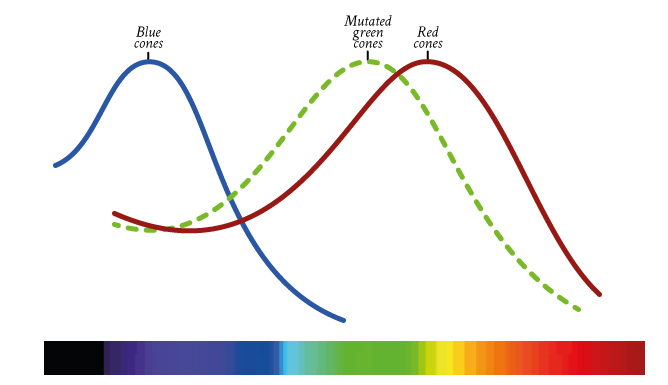what does green look like to a colorblind person
A Quick Introduction to Colour Incomprehension
Well-nigh 4% of the population has some form of color blindness. In this article we'll have a await at the nuts of how colour blindness works.
To see anything at all we need some tiny niggling helpers inside our eyeballs, the so called photoreceptors. There are 2 different types of them: rods and cones. Both of them are sitting on the retina at the back of your heart and pass data on to our brain. The rods are sensitive to light while the cones pick up color.
Each of the cones is carrying i out one of three different photopigments – carmine, green and blue – and reacts differently on colored light sources. For each of this 3 types at that place exists a specific color absorption curve with peaks at unlike points in the colour spectrum.
Mixing together the information of those three different types of cones makes upward our color vision.

Now, when ane blazon of cones malfunctiones the color this cone would ordinarily blot is contradistinct. This changes the color perception, resulting in a (somewhat) different way of perceiving color. This is what we telephone call colorblindness.
Types of colorblindness
The tree types of cones translate into tree main types of colorblindness: Deuteran (dark-green), Protan (cherry) and Tritan (blueish).
In each of these cases, the affected cones can either exist mutated or defective. A mutated cone causes a slight shift and a defective cone causes bigger shift in the color perception. This results in a total of six types possible types of colorblindness.
The Deuteran (greenish) and Protan (red) inefficiencies are the about common ones:
- Deuteranomaly: malfunctioning light-green cone (mutual)
- Deuteranopia: missing dark-green cone (rare)
- Protanomaly: malfunctioning blood-red cone (rare)
- Protanopia: missing cerise cone (rare)

Blue-blazon colorblindness is also possible, but very rare:
- Tritanopia: missing blue cone (very rare)
- Tritanomaly: malfunctioning bluish cone (very rare)
It'due south a male problem
Virtually 8% to ten% of the male population is colorblind. Colorblindness is most nowadays in males due to the way genetics piece of work (run across footnotes). Just an estimated 0.5% of the female person population is colorblind. Tritan-type colorblindness is not gender specific, women and men are as afflicted.
| Type | Prevalence |
| Deuteranomaly (green) | 4.63% |
| Deuteranopia (green) | one.27% |
| Protanomaly (blood-red) | 1.08% |
| Protanopia (carmine) | i.01% |
| Tritanomaly (blue) | 0.02% |
| Tritanopia (blue) | 0.03% |
It's not all black and white
In that location are many people who think the colorblind can't run across whatever colour. But the term is misleading, more than 99% of all colorblind people can see color.
Equally you can see, people with the two most common types of colorblindness – Deuteran (greenish) and Protan (carmine) – don't really suffer a radical change in the way they see colour.
However, they exercise accept limited ability to distinguish betwixt reds and greens (and whatever other colour that has their missing color in it), especially in shades of a certain colour. Something might look green, simply in certain situations it could too look ruddy or blueish.
The cherry-red and green cones lie quite close to each other in what colors they perceive (run across the graphs in a higher place). They intersect at various points; when the dark-green cones don't work, the red ones still pick up some green – and the other manner effectually.
The greens might not be as green as a non-colorblind person would perceive information technology, simply information technology'south however inside the category we would call green.
The Tritant (blue) colorblind have the blue finish of the spectrum missing or altered. There is very little intersection betwixt the other cones, this explains the big change in color perception.
The post-obit table lists some of the most problematic colors for each master blazon of colorblindness:
| Type | Problematic colors |
| Deuteran (green) | Dark-green/red, dark-green/blueish, green/grayness, green/brown, bluish/regal, orange/red, yellow/orange. |
| Protan (red) | purple/night bluish, orange/green, brown/night dark-green, red/brownish, greenish/xanthous, gray/purple |
| Tritan (blue) | blue/xanthous, violet/yellow-light-green, red/scarlet-purple, dark blue/black, xanthous/white |
In conclusion
All of this might sound a bit medical and confusing, only the basics are very simple:
The colorblind accept a narrowed colour perception. Green is still green and red stays red about of the time, simply not as vibrant or bright as a non colour bullheaded would encounter information technology. Colors lie closer to each other, peculiarly shades of colors.
Footnotes
The two mutual types of colorblindness (red-green and green-red) are the types of colorblindness that will be most discussed on this site. In that location are various other types of colorblindness with different perceptions, mutations and causes; they are all the same quite rare.
So as non to confuse the bulletin with different clauses or oddities I won't focus too much on these other rare types in general examples or articles. However, in the end any given solution or analysis will also work for these types of color blindness.
Much of the data in a higher place is based on and used with permission from the virtually excellent colblindor.com by Daniel Fluck. More data on the working of colorblindness can be found in the Colorblind Essentials series.
For more than information about the genetics side of colorblindness, take a look at this commodity on colblindor.com
Source: https://wearecolorblind.com/articles/a-quick-introduction-to-color-blindness/
0 Response to "what does green look like to a colorblind person"
Post a Comment